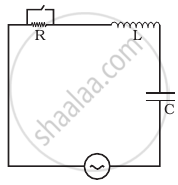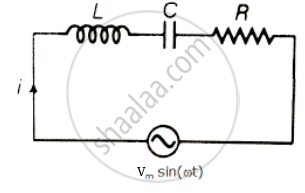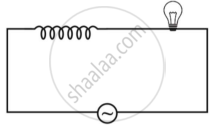Advertisements
Advertisements
प्रश्न
In the LCR circuit shown in figure, the ac driving voltage is v = vm sin ωt.
- Write down the equation of motion for q (t).
- At t = t0, the voltage source stops and R is short circuited. Now write down how much energy is stored in each of L and C.
- Describe subsequent motion of charges.

उत्तर
i. Consider series LCR circuit and tapping key K to short circuit R. Let i be the current in circuit. Then by Kirchhoff's voltage law, when key K is open.

VR+ VL + VC = Vm sin ωt
`iR + L (di(t))/(dt) + (q(t))/C - V_m` sin ωt = 0 .....[∵ i(t) = i = lm sin[ωt + `phi`]
⇒ As charge q(t) changes in circuit with time in AC,
Then `i = (dq(t))/(dt)`
`(di)/(dt) = (d^2q(t))/(dt^2)` .....(Differentiating again)
`R (dq(t))/(dt) + L (d^2q(t))/(dt^2) + (q(t))/C = V_m` sin ωt
`L (d^2q(t))/(dt) + R (dq(t))/(dt) + (q(t))/C = V_m` sin ωt
This is the equation for variation of motion of charge with respect to time.
ii. Let time-dependent charge in circuit is at phase angle with voltage then q = qm cos (ωt + `phi`)
i = `(dq)/(dt) = ω q_m sin (ωt + phi)` ......(I)
`i_m = V_m/Z = V_m/sqrt(R^2 + (X_C - X_L)^2)` ......(II)
`tan phi = (X_C - X_L)/R`
At t = t0, R is short-circuited, then energy stored in L and C, when K is closed will be, `U_L = 1/2 Li` ......(III)
At t = t0
i = im sin (ωt0 + `phi`) ......(IV)
From (II)
`i = V_m/sqrt(R^2 + (X_C - X_L)^2) sin (ωt_0 + phi)` ......(V)
∴ UL = `1/2[V_m/sqrt(R^2 + (X_C - X_L)^2]]^2 sin^2(ωt_0 + phi)`
UC = `q^2/(2C) = 1/(2C) [q_m^2 cos^2 (ωt_0 + pji)]`
Comparing (IV) and (I) Im = qmω
∴ `q_m = i_m/ω`
∴ UC = `1/(2C) * (i_m^2)/ω^2 cos^2 (ωt_0 + phi) = (i_m^2)/(2Cω^2) cos^2 (ωt_0 + phi)`
Using equation (II)
UC = `1/(2Cω^2) [(V_m^2)/(R^2 + (X_C - X_L)^2)]^2 cos^2 (ωt_0 + phi)`
iii. When R is short-circuited, the circuit becomes L-C oscillator. The capacitor will go discharging and all energy will transfer to L and back and forth. Hence there is oscillation of energy from electrostatic to magnetic and vice versa.
APPEARS IN
संबंधित प्रश्न
An AC source producing emf ε = ε0 [cos (100 π s−1)t + cos (500 π s−1)t] is connected in series with a capacitor and a resistor. The steady-state current in the circuit is found to be i = i1 cos [(100 π s−1)t + φ1) + i2 cos [(500π s−1)t + ϕ2]. So,
An AC source is rated 220 V, 50 Hz. The average voltage is calculated in a time interval of 0.01 s. It
A transformer has 50 turns in the primary and 100 in the secondary. If the primary is connected to a 220 V DC supply, what will be the voltage across the secondary?
A device Y is connected across an AC source of emf e = e0 sin ωt. The current through Y is given as i = i0 sin (ωt + π/2).
- Identify the device Y and write the expression for its reactance.
- Draw graphs showing a variation of emf and current with time over one cycle of AC for Y.
- How does the reactance of the device Y vary with the frequency of the AC? Show graphically.
- Draw the phasor diagram for device Y.
If circuit containing capacitance only, the current ______.
When an ac voltage of 220 V is applied to the capacitor C, then ______.
A capacitor has capacitance C and reactance X, if capacitance and frequency become double, then reactance will be ______.
Explain why the reactance provided by a capacitor to an alternating current decreases with increasing frequency.
Define Capacitive reactance.
An iron cored coil is connected in series with an electric bulb with an AC source as shown in figure. When iron piece is taken out of the coil, the brightness of the bulb will ______.

